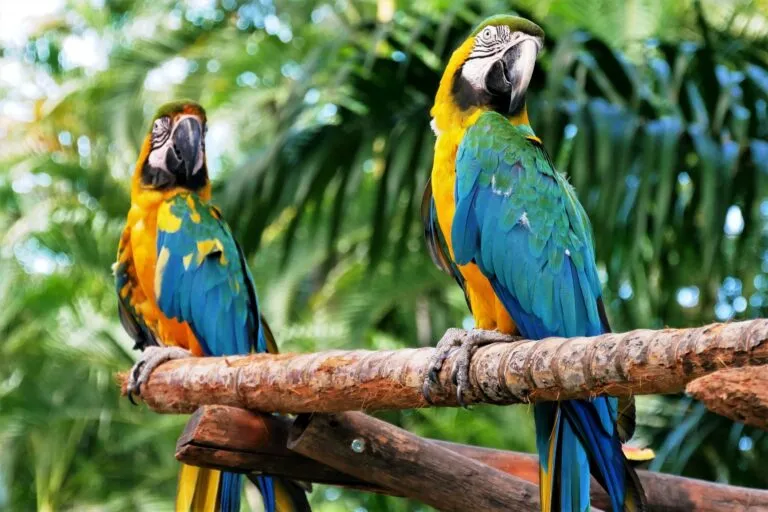There are several parrot diseases that cannot be recognised at first glance.
1. Aspergillosis: One of the best-known parrot diseases
Aspergillosis is probably one of the best-known parrot diseases. If your parrot inhales the fungal spores of the Aspergillus fumigatus fungus found in the environment through the air, they enter its respiratory tract where they form a dangerous fungal growth.
How to recognise and treat aspergillosis
Affected parrots typically suffer from respiratory problems (e.g. agonal respiration) and sometimes from neurological symptoms (e.g. spasms, tremors).
Once the vet has diagnosed aspergillosis, for instance, with an X-ray examination, they treat your parrot with anti-fungal medication (antimycotics). The effectiveness of the treatment depends on the extent of the fungal infestation.
2. Psittacosis: Notifiable infectious disease
Pittacosis is also one of the most important parrot diseases. It is a notifiable bacterial infectious disease and is triggered by Chlamydia psittaci.
Chlamydia enters the body of different bird species via different pathways and leads to flu-like symptoms when the disease breaks out.
However, the disease can also affect both other animals and humans, when it is referred to as ornithosis.
How is psittacosis recognised and treated?
In case of suspicion, vets send swab samples to a laboratory that cultivates the bacteria or detects them by molecular biology. If the laboratory confirms the suspicion, your vet will treat your parrot with antibiotics. You should also follow the mitigation strategies suggested by your vet.
3. Pacheco’s disease: An often undiscovered parrot disease
Herpes viruses cause Pacheco’s disease in parrots. If your bird becomes infected with the causal virus through the air or its beak, it will infect numerous organs through the blood. However, most parrots or parakeets only get sick when they suffer from stress, but they die within a few days once they do show symptoms.
How is Pacheco’s disease recognised and treated?
Before birds die, their general condition is poor and they show gastrointestinal symptoms. As a result, vets only have a short period of time to detect the virus via a swab sample, which is why a pathologist usually makes the diagnosis first.
4. Psittacine beak and feather disease (PBFD)
Parrots and budgies contract deadly PBFD – also known as feather loss syndrome – via a droplet infection with circoviruses, which settle in the feather follicles, skin, oesophagus and goitre. Depending on the age of the infected bird, it becomes ill either peracutely (extremely fast outbreak), acutely or chronically.
Can you treat PBFD?
PBFD typically leads to changes in your exotic bird’s feathers and bones. If the vet has detected circoviruses via a PCR test, they can only prescribe your parrot supportive medication such as painkillers or vitamins. Unfortunately there is still no cure for this dangerous parrot disease.
5. Neuropathic gastric dilation (PDD): Fatal neurological disease
Researchers have not yet been able to clarify the exact cause of neuropathic gastric dilation (proventricular dilatation disease, PDD) in birds. However, they suspect that bornaviruses cause this fatal neurological disease.
Parrots, parakeets and other bird species too can become infected via contact with contaminated faeces or feather dust. In the body, the avian bornaviruses that prefer to infect birds cause the nervous tissue to become inflamed.
How is this parrot disease recognised?
Infected birds gradually lose weight. They die acutely when their glandular stomach ruptures. The two typical characteristics of PDD are therefore gastric dilation and gastric wall thinning. Since there is currently no cure available to vets, treatment is based solely on supportive measures.
6. Polyoma virus: Budgies predominantly affected
Polyoma viruses predominantly affect budgies, so they are not a parrot disease strictly speaking. However, vets have also reported cases in some parrot species (e.g. macaws or eclectus parrots). They become infected through contact with contaminated faeces or feather dust. The viruses then migrate via the blood to the nervous system, skin and inner organs (e.g. liver).
How are polyoma viruses recognised and treated?
The course and clinical symptoms of a polyoma virus infection depend heavily on the age of the affected parrot. Should the vet have a suspicion, they can directly or indirectly detect the virus through several samples. There is currently no known remedy for polyoma virus, so vets can only relieve the symptoms.
